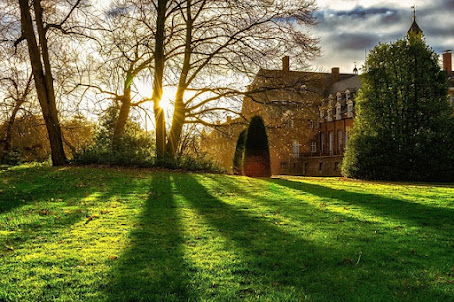Part Sun? Part Shade?
Determining Sunlight Exposure in Your Yard
Determining the sunlight exposure in your growing spaces can be less confusing if you know the reason behind the sun exposure terms used on seed packets and plant tags.
There are probably several areas in your garden that fall into the following different categories as well as a mixture or combination of each.
Generally, categories of sunlight exposure include: "full sun," "part sun," "partial sun", "full shade," "part shade," "partial shade," "dappled sun," "dappled shade." On top of that, there are mixed categories including terms like "Full Sun to Partial Shade" or "Partial Shade to Full Shade."
While the plant tags or seed labels may make a plant seem suitable for any location, you may need to do a bit more research to tell you that the plant really does best under a specific sunlight exposure but "tolerates" other conditions.
Full Sun
A garden site is considered full sun as long as it gets at least 6 full hours of direct sunlight on most days. It is not necessary that the site receive direct sunlight for all hours of the day.
There are many plants that will thrive in more than 6 hours of daily sun. These are generally also well suited to handle dry growing conditions once they become established. Whatever full sun plants you choose, a thick layer of mulch will help conserve moisture in the soil and keep the roots cool.
Plants that prefer full sun is by far the largest group you will encounter, and that's why vegetable gardens are generally best positioned in the very sunniest location you can find.
The vast majority of flowering annuals and perennials will enjoy full sun, provided their moisture requirements are met. These vegetables include tomatoes, cucumbers, peppers. beans, corn and squash.
But while many plants need the full sun area to set buds and flower, there are some that cannot handle the intense heat and/or dry conditions that often come with that much direct sunshine.
But while many plants need the full sun area to set buds and flower, there are some that cannot handle the intense heat and/or dry conditions that often come with that much direct sunshine.
Vegetables can dissipate a large amount of summer heat if they are healthy and getting enough water. But in extreme temperatures of 90 to 100 degrees, most plants will begin to suffer, especially if their soil is dry.
In southern areas, a way around excess heat on your plants is to site them where they will get more of their direct sun in the morning when it is cooler, with some shade in the afternoon. As long as the plants get at least 6 hours of direct sunlight, they should grow well.
Part/Partial Sun
Part or partial sun means four to six hours of direct sun every day.
If a plant is listed as "partial sun," greater emphasis is put on the plant receiving at least the minimal sun requirements.
These plants need several hours of sun to set flowers and fruits, but are not as fussy as the full sun worshipping plants that need a full day of sun. You may need to experiment to find the ideal spot in your garden for plants listed as needing partial sun.
Vegetables that are susceptible to bolting can benefit from being grown in partial sun, particularly in hotter climates. These would include cauliflower, spinach, broccoli and the like. For areas that receive morning sun then afternoon shade, vegetables such as celery, carrots, and bush beans will grow well.
 |
| Click to View |
Full Shade
"Full shade" does not mean no sun, since very few plants, other than mushrooms, can tolerate complete darkness.
Plants that list their sunlight requirements as "full shade" are those that can survive on less than 3 hours of direct sunlight each day, with filtered sunlight during the rest of the day. Coral Bells, Hosta, Astilbe are all considered full shade plants.
 |
| Click to View |
Part/Partial Shade
Partially shaded sites receive both sun and shade at various intervals. Plants in partial shade may receive direct sun throughout the day for a few hours with at least half the day spent in shade. Partial shade implies that the plant should be protected from the sun during the afternoon. "Cool sun" refers to morning sun.
These plants will need some relief from the intense heat of late afternoon sun. You can easily accomplish this either by planting where a nearby tree will cast afternoon shade or by planting on the east side of a building where the area is blocked from the direct afternoon sun. Plants for partial shade include impatiens and begonias.
Dappled Sun
Dappled sun is similar to partial shade. It is the sun that makes its way through the branches of a deciduous tree. Woodland plants, like trillium and Solomon's Seal, as well as understory trees and shrubs, prefer this type of sunlight over even the limited direct exposure they would get from partial shade.
 |
| Click to View |
Full Sun to Partial Shade
The sunlight requirements for many plants will include terms like "Full Sun to Partial Shade" or "Partial Shade to Full Shade."
This indicates that the plant will do fairly well in a range of sunlight exposures, which gives you more flexibility in determining where you can plant it.
Just remember that many such plants still have a preferred sunlight requirement under which they do best.
 |
| Soil Light Meter Click to View |
~~~~~~~~~~~~
Placing plants in the right amount of sunlight will reward you with the best odds for the plant to grow healthy and beautiful.
While the sunlight requirement suggestions on plant tags give you a start at siting the plant in just the right location, further investigation may be needed to avoid needing to move the plant later.
~~~~~~~~~~


Comments
Post a Comment